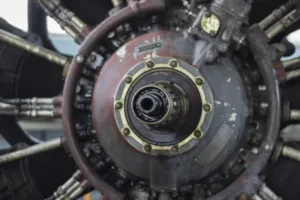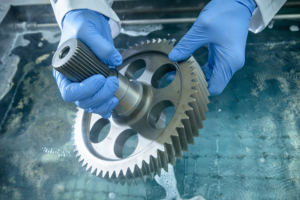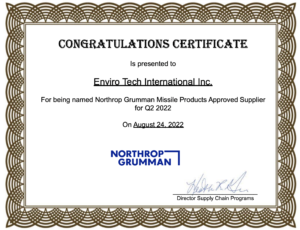Vapor degreasing is a quick, economical and simple process for cleaning even the dirtiest manufactured parts — both metal and plastic — using a thermo-mechanical still and a vaporized solvent.
How Vapor Degreasing Works
The vapor degreaser is a machine that works much like a still. The base of the machine includes a heating element under a reservoir, known as the boil sump. Alongside the heating element, there may be a device that creates ultrasonic currents. These are sent into a taller reservoir next to the boil sump, known as the rinse sump. Both sumps are filled with a degreasing solvent such as EnSolv® degreaser.
Step 1: As the heating element warms the EnSolv® to its boiling point (70 degrees Celsius), vapor forms and rises to the next level of the chamber. The hot vaporized solvent is contained in the chamber by the cooling coils located above, close to the top of the chamber. Pieces are slowly lowered into the vapor chamber, where the cleaning process starts.
As the hot vapor surrounds the cool pieces, the degreaser dissolves the dirt. As the EnSolv® begins to cool and condense on the surface of the parts, it drips back into the boil sump, taking grease and grit along with it. This step usually takes a few minutes to complete.
Step 2: If the parts are not fully degreased after the vapor cleaning procedure — or if there are textured or deep surfaces or channels in or outside the parts — they can be fully immersed into the boil sump to continue cleaning away grease and debris. The degreaser will easily flow into any crevices or hollows in the parts.
Step 3: Once the vaporized degreaser has finished condensing and has dropped back into the boil sump, the pieces are ready to be lowered slowly into the rinse sump to clean away any lingering dirt. It is important to do this slowly to avoid splashing the solvent. The rinse sump is filled with clean EnSolv®, which is continuously being recycled and purified through the cooling coils above. As the recycled and purified solvent fills the rinse pump to overflow capacity, the degreasing solvent refills the boil sump.
Some rinse sumps incorporate ultrasonic impulses that agitate the EnSolv®, further enhancing the cleaning properties of the degreaser. When the rinsed pieces are slowly pulled back into the vapor chamber, the degreaser once again cools and condenses before falling back into the rinse sump below. The pieces are now clean, dry and cooled. They are ready for the next step in the manufacturing process.
The Importance of Degreasing
Now that we know how vapor degreasing works, let’s find out why this thorough cleaning process is necessary.
Many times, manufactured parts need to be painted, soldered, welded or electroplated — or they may require some similar processes to prepare them for assembly. Many problems are associated with improperly cleaned parts. All of these conditions could create weaker, less desirable finished products — and, in fact, would be unlikely to pass through quality control. Clean parts are safer, stronger and more durable.
If surfaces have residue left from the manufacturing process, any finishes applied to them will not coat evenly. This may leave raw metal exposed on the pieces, inviting rust and corrosion. Welds on uncleaned or greasy surfaces may not fuse tightly, resulting in cracked or porous weld joints. These failed welds can be dangerous, inconvenient and expensive.
Enviro Tech’s EnSolv® 5408 degreaser is a safer alternative for employees and the environment than other industrial degreasers. Enviro Tech’s patented formula uses stabilized n-propyl bromide (nPB) to replace conventional degreasers such as trichloroethylene (TCE), perchloroethylene (PERC) and 1,1,1-trichloroethane.
Enviro Tech’s EnSolv® degreaser is used in a variety of industries:
- Aerospace
- Medical
- Electronics
- Oil production
Vapor degreasing with EnviroTech’s EnSolv® is an economical, safe and simple solution for any manufacturing process that involves dirty, greasy components. EnSolv® leaves nothing behind, no oxidation, no water spots, no worries.





